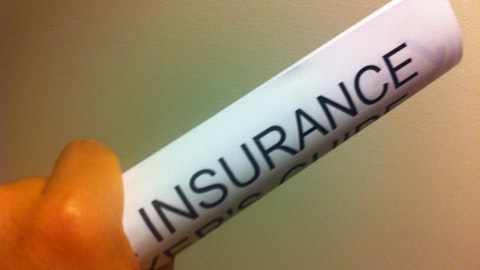Tracy Benguigui: While you posted double-digit insurance premium growth this quarter, the pace has decelerated a bit over the last two years. It looks like peak insurance premium growth was in mid-’21, and that might be a tough benchmark given you’ve grown a ton and professional ability and you are shrinking error, as you pointed out. Could we expect insurance premium growth at double digits to be sustainable going forward? Or should we see it fall to high single digits because of the professional lines headwind? And I’m just wondering if it’s fair to assume that you prefer deploying capital into reinsurance now, all else being equal?
Marc Grandisson: Yes. In terms of return expectations, I think your instinct is right on. I think reinsurance is providing right now very, very healthy returns. We expect this to continue into ’24 and ’25, to be honest. But the insurance group, I think it’s one quarter, there’s couple of moving parts due to some accounting thing, timing and stuff here and there sometimes. But as François mentioned, the growth in the line that we like to see growth into I’m very pleased to see because this is where I would expect the team to grow it but the market conditions are great there. And I would expect even some of those nonprofessional lines to actually maybe carry the day bit more going forward. I wouldn’t be surprised that we could go back above 10% next quarter and into 2024. So I’m not — I don’t see one quarter of the trend, to be honest.
Tracy Benguigui: Right very helpful. You slightly shortened the duration of your asset portfolio in September to 2-point, nine, seven years from 3.03 years in June. It feels like you’re taking durational asset mismatch because the MI liabilities are much longer dated. Given the shape of the yield curve is beginning to show signs of steepening, I mean to tad bit less inverted. Going forward, would you consider lengthening your asset duration? Or you feel comfortable with the sub-3-year duration level?
François Morin: Good point. I think the duration is probably the lower it’s been in a long, long time, and that’s just our investment professionals here again make the decisions, and there’s obviously a little bit of tax expats involved and kind of where they want to play at a certain point in time. But for sure, absolutely. If interest rates, we think the longer the curve ends up being a bit more attractive. I mean, we certainly consider extending the duration a little bit. And we’ve got a bit of room there anyway just to match with the liabilities to make sure that we’re not mismatch there. So that’s certainly something that we’ll look at in the coming months and quarters, yes.
Operator: Our next question comes from the line of Yaron Kinar from Jefferies.
Yaron Kinar: First question, it sounds like you are pretty constructive looking into 1/24. Can you maybe talk about your prioritization of capital? And maybe give us a way to think about maybe potential available capital you have to deploy into the insurance and reinsurance markets?
François Morin: Well, yes, we are constructive on 1/1. I think we — Marc and I said it, I think it’s a really good market in totality. There’s some pockets that are certainly better than others. We think that the internal capital generation, we’ve been able to generate in the last few quarters gives us the ability to really grow and take advantage of the opportunities that we think have a good chance of being there. Again, we don’t make the market. We participate in the market. So if the market is as positive as we think it can be, then we’ll be happy to step in and take a bigger share of it. But I think the fact that we’ve got capital flexibility has always been one of the — and on a onetime things and our strategy all along is we want to make sure that we have plenty of capital to deploy when the market is right. And so far, we’ve been able to do that.
Marc Grandisson: So Yaron, if I look at the high level, the way we think about — we think about it, it’s different perhaps than even our underwriting units, meaning that they don’t really, they were doubting how much capital is allocated to them at the beginning of the period. I want to remind everyone that people write the business or underwriting fee write the business. And then we — after that, charge them with the capital they’ve been using. And based on the planning and all the expectations that we have, our message there has been — there is no capital constraint or issue concerns that, that pertains to you guys. If you see the market being a better and even get better than we saw, feel free to deploy more capital if you wish to do so.
So there’s definitely there’s all hands on deck go forward if we can invite the business. That’s one thing that’s really nice and we’ll then attribute the capital after we have written the business. That’s what we do every year. On the property cat side, which is probably a more interesting one for is worth to you, we’re about 85% allocated to the reinsurance group in terms of PML thatFrançois mentioned. And I think it’s because the returns there are a little bit more favorable on the reinsurance side. And then we had the discussion at the group level. That’s one exception. So when we have an acute or a specific area of the capital, we’ll sit down with the Insurance Group and Reinsurance Group with Nicolas facilitating the whole discussion, and we’ll sort of decide to roughly broadly where we want to allocate capital.
Yaron Kinar: I appreciate that. And then certainly, I think the capital availability and the appetite to deploy is a very important part of the or story. And I guess from that perspective, is there anything you can offer us in terms of an attempt to quantify the available capacity? Or is that something that we’ll just have to watch and see?
François Morin: Yes. I mean, we — certainly, we have some capital — we have plenty of capital available. We just don’t know what the market will look like at 1/01. So that’s why I’d say you’re right, probably have to — what you see a little bit, see how 1/1 play out and then we’ll have the ability to do something with the excess capital in.




